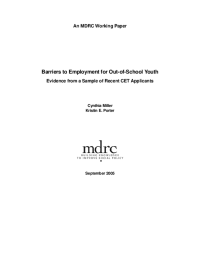Barriers to Employment for Out-of-School Youth
Evidence from a Sample of Recent CET Applicants
This working paper examines employment and earnings over a four-year period for a group of disadvantaged out-of-school youth who entered the Evaluation of the Center for Employment Training (CET) Replication Sites between 1995 and 1999. It assesses the importance of three key factors as barriers to employment: lack of a high school diploma, having children, and having an arrest record. The findings show that dropouts worked less than high school graduates, largely because of greater employment instability among men and because of both instability and longer spells of joblessness among women. Female dropouts had especially low employment rates and wages, and the negative effects of dropping out occurred primarily among women with children. Male dropouts did as well as high school graduates in terms of wages, although their overall job quality remained lower. For women, the results show no negative effects on employment or wages of having children at study entry. Although not measuring the effects of new births, these results suggest that any effects of early childbearing may be short-lived. Finally, men with previous arrests worked less over the follow-up period than other men, owing entirely to longer spells of joblessness, and they earned substantially lower wages. The findings suggest that these men may have faced an increasingly difficult time finding jobs as the economy weakened.






